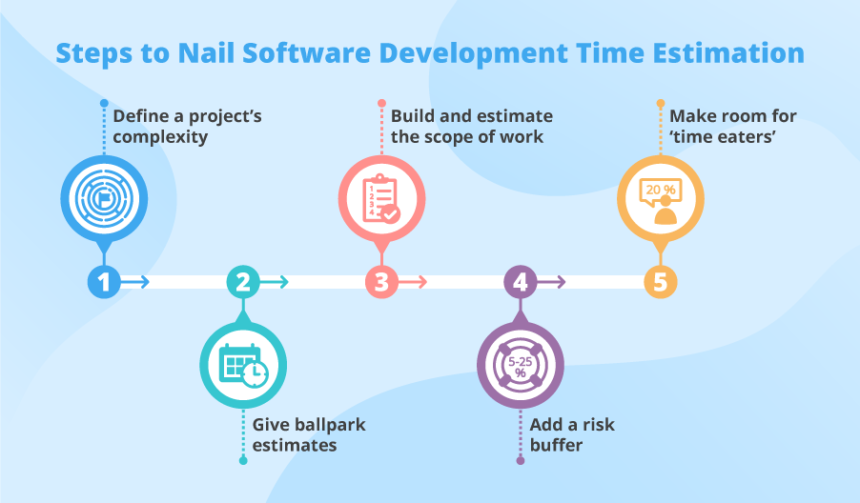Software project estimation methodologies help project managers accurately estimate crucial project parameters like cost and scope. Project managers can then use these estimation tactics to give clients more realistic projections as well as budget the cash and resources they’ll require for a project’s success.
In this article, we’ll go over which project parts should be estimated, the many project estimating methods accessible, and how to get started with estimation techniques that are extremely useful for software project estimation in software engineering.
Why Are Project Estimates Important?
Accurate estimates are crucial for successful project planning and execution. Without exact estimates, it is difficult to establish how long a project will take or how many resources are required. These estimations are used by project managers to guarantee that the team has access to the necessary people, materials, and tools at all times. These estimations also assist managers in setting realistic goals and expectations for their team members and stakeholders.
Who Estimates Software Project?
The software development team is normally in charge of software project estimation. Although the project manager may be in charge of the database or documents used to record estimates, the entire team, including subject matter experts, must participate in developing and refining the estimates.
Types of Estimations During a Project?
Project estimation approaches can help with six major elements of a project:
-
Cost:
Cost is one of the three most important limitations in project management. If you do not have enough money to finish the project, it will fail. If you can effectively estimate project costs early on, you can help set customer expectations while also ensuring you have the money to complete the work. Therefore, cost estimation entails predicting how much money you will need for the project and when you will need it.
-
Time:
Project planning requires the ability to forecast both the overall project time and the timing of individual tasks. Estimating your project schedule allows you to ensure that people and resources are available when you need them. It also allows you to manage customer expectations for critical deliveries.
-
Scope:
Scope is the third major Software Projectt limitation. The project scope includes all of the work required to complete the project or deliver a product. Estimating how much work is involved and what activities must be completed can guarantee that you have the necessary resources and experience for the project. The three primary restrictions are sometimes referred to as the three sides of a triangle. This is because any adjustments to one limitation will necessarily affect the other two. To effectively estimate the budget, you must first understand the scope and timetable. If one of the three is bigger or less than predicted, the other two estimations are likely to be incorrect as well.
-
Risk:
Project risk is an unexpected event that could impact your Software Project, for better or for worse. Estimating risk involves predicting what events may occur during the project’s life cycle and how seriously they could impact the project. By estimating what risks could impact your project and how they will affect it, you are better able to plan for potential issues and create risk management plans.
-
Resources:
Project resources are the assets required to complete the project. Resources can include tools, people, materials, subcontractors, software, and other items. Resource management ensures that you have all of the resources you require and use them as efficiently as possible. It is difficult to plan how to manage resources unless you know what you will need and when. This can result in workers sitting idle or things not arriving until weeks after you need them.
-
Quality:
Quality refers to how well project deliverables are completed. Products that must comply with stringent quality criteria, such as environmental constraints, may need more money, effort, and other resources than those with lower requirements. Estimating the level of quality required by the customer allows you to plan and estimate the remaining five parts of your project.
All six project components are interconnected, so projections for one can influence estimations for the other five. As a result, employing the same project estimation methodologies in all six areas might increase your accuracy.
Major Project Estimation Techniques:
Some of the most important techniques for software project estimation are listed below:
-
Top-Down Estimate:
Top-down estimating allocates an overall amount of time to the project and then divides it into individual phases, work, and tasks based on the project’s work breakdown structure (WBS). If a client says that the project must be completed in six months, a top-down method lets you look at the whole timeline and estimate how much time you can devote to each project activity while still achieving the client’s deadline.
-
Expert Judgment:
Expert judgment is one of the most commonly utilized estimation approaches due to its speed and simplicity. This form of project estimation is based on expert knowledge and intuition. It’s particularly useful when you’re planning a regular project that your team has already completed or is familiar with. Expert judgment can be applied to both top-down and bottom-up estimations.
-
Comparative or Analogous Estimation:
Comparative estimation is a top-down approach that uses historical project data to estimate project length. If prior projects took an average of eight months to complete, the present one should take the same length of time. Then, to obtain lower-level work estimates, divide the eight months into tasks and activities.
-
Parametric Model Estimation:
Parametric modeling also uses past Software Project data, but it adjusts the data each time to represent the variations between projects. This method estimates the current project by prorating the details of past projects you’ve performed. Assume your company is in the business of building houses. To compute the average project cost per square foot of the house, use metric modeling to divide the total cost of all past construction projects by their square footage. Then, multiply that figure by the current home’s intended square footage to get the total Software Project budget.
-
Bottom-up Estimate:
Bottom-up estimates are the polar opposite of top-down estimates. You start by estimating each task or feature of the project using this technique. Then you combine all of the individual estimates to get the overall project estimate.
This form of estimate is more accurate than the top-down method since each activity is evaluated separately. However, it takes longer to complete a software estimate and needs more effort from both the Software Project manager and the business analyst.
-
Three-Point Estimation:
Three-point estimating is a technique used to get bottom-up estimates. Instead of assuming a single timeframe for work, consider assigning three: optimistic, pessimistic, and most likely. These three statistics are averaged to generate your final estimate. The PERT (Program Evaluation and Review Technique) technique employs three-point estimation, but it takes a weighted average of the three points, with the most likely assumption taking precedence.
Conclusion:
In the field of software development, reliable Software Project estimation is critical. Our software developers at Hashlogics make realistic estimation plans by analyzing the project scope, dividing down tasks, and using various estimation approaches. However, for software project estimation, considering risks and proper communication are essential to ensuring project success.


